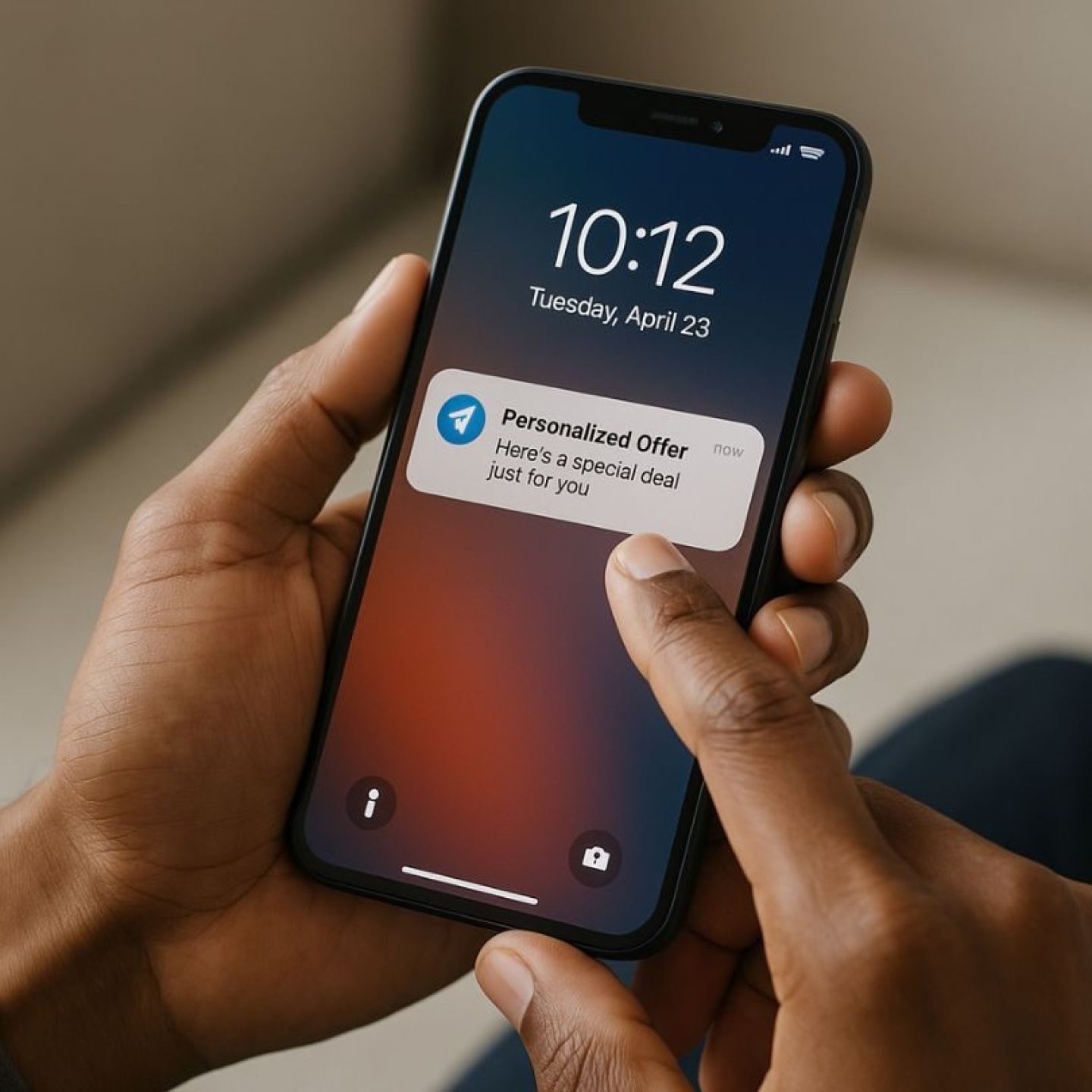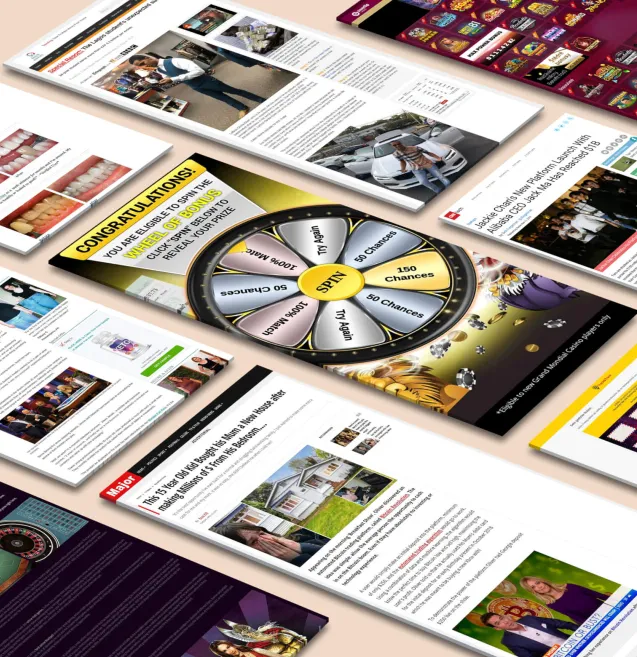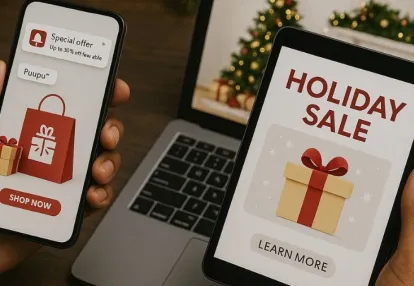
Our spy tools monitor millions of push notification ads from over 90+ countries and thousands of publishers.
Get StartedHave you ever wondered how some apps always seem to know exactly what you need, right when you need it? That's the magic of dynamic push notifications in action. Unlike traditional one-size-fits-all messages, these smart alerts change in real-time based on your users' actions, preferences, and situation.
Dynamic push notifications are a game-changer for brands trying to connect with their audience. Instead of sending out generic messages to everyone, you're now able to send personalized push campaigns that speak directly to each user's needs. This strategy, known as behavior-based push marketing, uses AI and machine learning to analyze user behavior, location data, and engagement trends—then creates messages that truly resonate.
The results speak for themselves. When you understand and use user behavior through dynamic push notifications, you're not just sending messages—you're creating meaningful relationships. This leads to higher engagement rates, better customer retention, and more conversions. Often, the difference between a notification that gets ignored and one that prompts action is simply personalization and timing.
Dynamic push notifications represent a fundamental shift from the one-size-fits-all approach of traditional messaging. These intelligent notifications analyze user behavior in real-time, examining patterns like browsing history, purchase activity, app usage frequency, and interaction timing to deliver messages that align with each user's current context.
The adaptation process happens across multiple dimensions:
AI-driven push notifications operate through sophisticated machine learning models that continuously process incoming data streams. These models identify patterns you might never spot manually: which product categories resonate with specific user segments, what time windows generate the highest conversion rates, or which message formats drive the most engagement.
The technology stack behind real-time personalization includes:
Machine learning systems improve with every interaction. When users engage with certain notification types and ignore others, the AI adjusts its approach. If someone consistently dismisses promotional messages but responds to informational updates, the system learns to prioritize content over sales pitches for that individual.
This intelligent adaptation transforms push notifications from interruptions into valuable touchpoints. You're not broadcasting generic messages to your entire user base—you're delivering personalized experiences that respect each user's unique journey with your brand.
User segmentation push ads transform generic broadcasts into precision-targeted messages that speak directly to individual user needs. You can't expect every user to respond to the same message—a first-time visitor has different needs than a loyal customer who's made ten purchases. Segmentation allows you to recognize these differences and craft messages that align with where each user stands in their journey.
Zero-party data forms the foundation of your most accurate segments. This information comes directly from users who voluntarily share their preferences, interests, and intentions. When a user tells you they're interested in running shoes or prefers notifications about weekend sales only, you're working with explicit consent and clear direction. You're not guessing—you're responding to stated preferences.
First-party data complements this by tracking actual user behavior within your app or platform. You collect this data through:
Behavioral triggers activate your segments at critical moments. When a user abandons their cart, views a product multiple times without purchasing, or hasn't opened your app in two weeks, these actions signal specific needs. You can create segments that respond automatically to these behaviors, sending timely reminders or personalized incentives that address the exact hesitation or interest.
The combination of zero-party and first-party data with behavioral triggers creates dynamic segments that evolve as users interact with your platform. A user might start in your "new visitor" segment, move to "active browser," then "cart abandoner," and eventually "loyal customer." Each segment receives messages tailored to their current relationship with your brand, making every notification feel relevant rather than random.
Dynamic Push Notifications: Tailoring Messages Based on User Behavior requires a strategic approach to content personalization that goes beyond simply inserting a user's name. You need to build campaigns that speak directly to where your users are in their journey with your brand.
Start by mapping your message content to specific user actions and contexts. Here are some examples:
Timing optimization plays an equally critical role in personalized push campaigns. You can craft the perfect message, but sending it at 3 AM when your user is asleep renders it useless. Analyze your user data to identify when individual segments are most active and receptive. Here are two examples of timing optimization:
The frequency challenge demands careful attention. You're walking a tightrope between staying top-of-mind and becoming a nuisance. I've seen brands lose 30% of their user base by sending daily promotional pushes without considering user preferences. Set intelligent frequency caps based on engagement patterns:
Create value hierarchies for your messages. Transactional notifications (order updates, security alerts) take priority over promotional content. Time-sensitive offers warrant immediate delivery, while general announcements can wait for optimal engagement windows.
Test different content formats within your personalized push campaigns. Some users respond to urgency-driven messages ("Only 2 left in stock"), while others prefer value-focused content ("Save 20% on items you viewed"). Your segmentation data should inform which approach resonates with each user group.
Dynamic push notifications have found applications across various industries, revolutionizing how businesses engage with their customers. Here are some key use cases:
E-commerce platforms have transformed their customer engagement through intelligent product recommendations and abandoned cart reminders. When you browse a specific category or add items to your cart without completing the purchase, dynamic push notifications can trigger personalized messages featuring those exact products, often sweetened with time-sensitive discounts.
Travel and hospitality businesses leverage location-based messaging to enhance the customer journey.
Financial services utilize real-time updates to keep you informed and engaged with your money.
Media and entertainment apps send notifications about new content releases matching your viewing preferences, while sports apps deliver live score updates for teams you follow, creating timely engagement opportunities that align with your interests.
To make dynamic push notifications work for your business, you need a solid foundation. User trust is your most valuable asset—lose it once, and you'll struggle to win users back. The key lies in respecting user preferences and giving them control over what they receive and when they receive it.
Message relevance determines whether users engage with your notifications or disable them entirely. You should analyze user behavior patterns to understand what truly matters to each segment. A user who browses athletic shoes at midnight has different needs than someone checking product reviews during lunch breaks. Your notifications must reflect these nuances.
Your timing strategy makes the difference between a welcomed message and an intrusive interruption. Consider these essential elements:
You can't afford to blast generic messages at maximum frequency. Start with conservative sending patterns and gradually increase based on engagement metrics. Users who consistently open notifications within minutes can handle more frequent updates than those who check weekly.
Permission management deserves careful attention. You should implement granular notification preferences that let users choose specific categories they want to receive. A user interested in price drops might not care about new product launches—give them that choice upfront.
Testing remains critical for optimization. You need to A/B test message copy, timing windows, and personalization elements to discover what resonates with different user segments.
One effective method to enhance your push notification strategy is by leveraging dynamic push notifications. This approach allows you to dominate push notification advertising by uncovering profitable push ads from the most successful advertisers and marketers in your industry.
Your dynamic personalization strategy shouldn't stop at push notifications. The same behavioral data and AI-driven insights that power your push campaigns can transform your entire cross-channel customer experience.
When you integrate dynamic personalization across multiple touchpoints, you create a cohesive journey where each interaction builds on the last. A user who abandons their cart might receive a push notification within the hour, followed by a personalized email the next day, and then see dynamic in-app messaging when they return to browse. Each channel reinforces the others, using the same behavioral triggers and user preferences to maintain consistency.
SMS marketing becomes exponentially more powerful when you apply the same dynamic principles. Instead of sending generic promotional texts, you can deliver time-sensitive offers based on location data, purchase history, and real-time inventory levels. A retail app might send an SMS about a flash sale on items similar to what you've browsed, timed precisely when you're near a store location.
The technology stack you need includes:
You need infrastructure that processes millions of data points per second, making split-second decisions about which message to send through which channel. Modern personalization platforms use machine learning models that continuously analyze response patterns, automatically adjusting your cross-channel strategy to maximize engagement without requiring constant manual intervention.
You need concrete metrics to understand whether your dynamic push notification strategy actually works. Conversion rates serve as your primary indicator—track how many users complete desired actions after receiving notifications, whether that's making a purchase, booking an appointment, or upgrading their subscription. I've found that comparing conversion rates between dynamic and static campaigns reveals the true value of personalization.
User retention metrics tell you if your notifications keep people coming back or drive them away. Monitor day-7, day-30, and day-90 retention rates alongside opt-out percentages. If you notice declining retention after implementing dynamic notifications, you're likely over-messaging or missing the mark on relevance.
AI optimization models transform your campaign performance through continuous learning. These models analyze patterns across millions of user interactions to identify:
You should track engagement metrics like open rates, click-through rates, and time-to-action. These granular data points feed your AI models, enabling them to refine targeting parameters automatically. I recommend setting up A/B tests that run continuously, allowing your system to test new message variations against control groups.
Revenue per notification provides a direct link between your messaging efforts and business outcomes. Calculate this by dividing total revenue attributed to push notifications by the number of messages sent. This metric helps you justify investment in more sophisticated personalization technology and guides budget allocation across channels.
Dynamic push notifications benefits extend far beyond simple message delivery—they represent a fundamental shift in how you connect with your audience. The data speaks clearly: businesses implementing behavior-based messaging strategies consistently see measurable improvements in customer loyalty and revenue growth.
You're standing at the intersection of technology and customer experience. AI-powered personalization isn't just a trend; it's becoming the baseline expectation for modern consumers. Users demand relevance, and Dynamic Push Notifications: Tailoring Messages Based on User Behavior gives you the tools to meet that demand.
The competitive advantage goes to brands that act now. Start small if you need to—segment one user group, test one dynamic campaign, measure the results. You'll quickly see how personalized messaging transforms passive users into engaged customers.
Your audience is ready for conversations that matter. Are you ready to deliver them? The technology exists, the strategies are proven, and the opportunity to differentiate your brand through intelligent, contextual communication is here.
Receive top converting landing pages in your inbox every week from us.
Tips & Tricks
Push notifications can be a powerful tool for driving engagement and conversions during the festive season. Discover practical tips for crafting timely, personalized, and irresistible messages that capture attention instantly. Learn how to balance frequency, tone, and timing to maximize results without overwhelming users. Perfect for marketers ready to make their holiday push campaigns truly impactful.
Liam O’Connor
7 minDec 2, 2025
Must Read
Successful holiday marketing goes beyond a single channel—it’s about creating harmony between Native, Push, and Pop ads. Learn how to integrate these three formats to reach audiences at every stage of the buying journey. Discover strategies for maximizing visibility, engagement, and conversions during the busiest shopping season. A must-read for advertisers aiming to deliver cohesive, high-impact holiday campaigns.
Priya Kapoor
7 minNov 30, 2025
Must Read
This blog uncovers how AI can transform holiday marketing campaigns into high-performing, data-driven successes. It explains how AI tools help optimize targeting, personalize messaging, and predict consumer behavior for better engagement. Readers will learn practical ways to fine-tune their campaigns and boost conversions during the busy holiday season. Ideal for marketers looking to maximize results and efficiency with AI-powered strategies.
Marcus Chen
7 minNov 21, 2025




